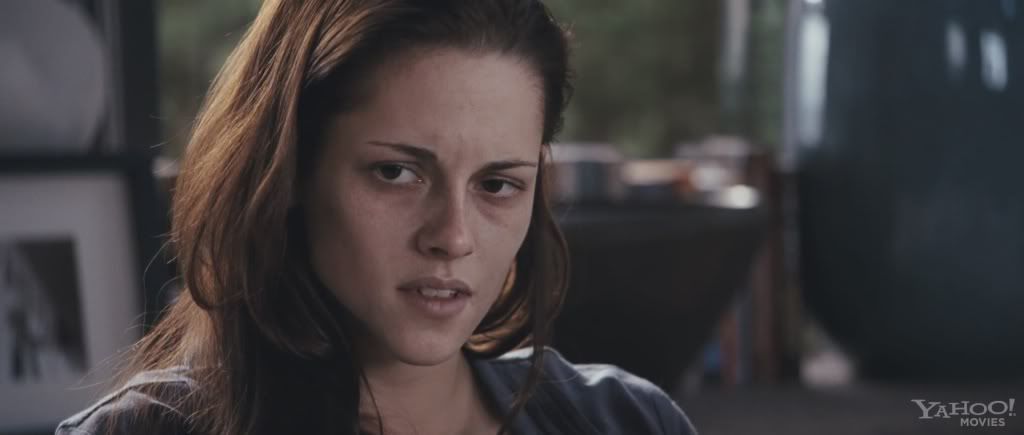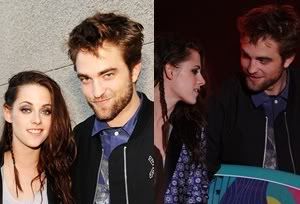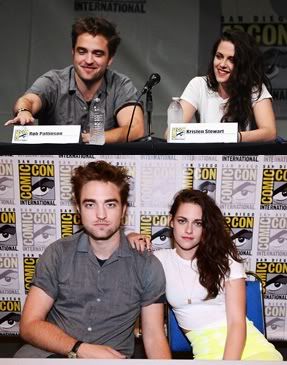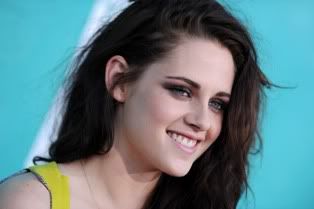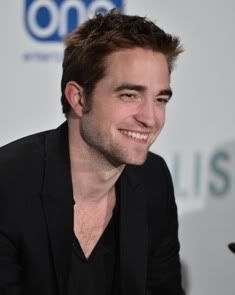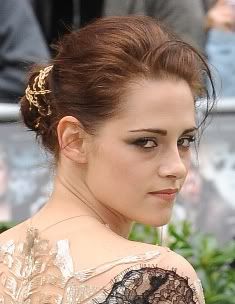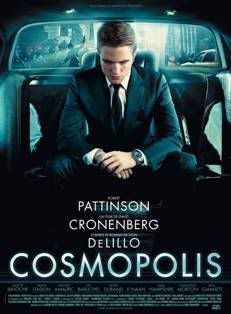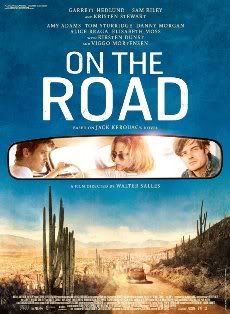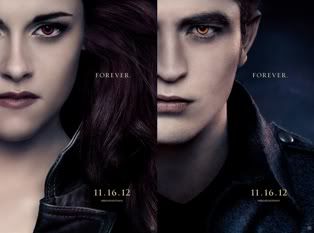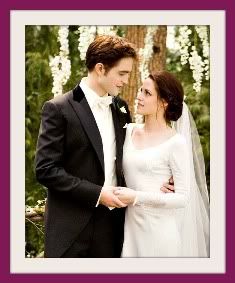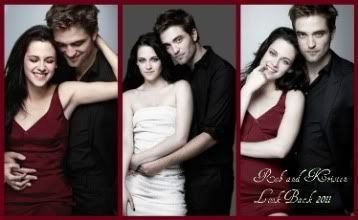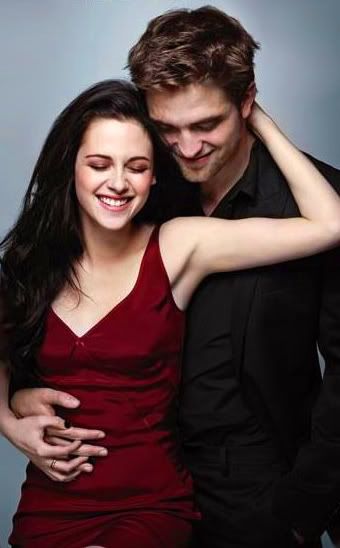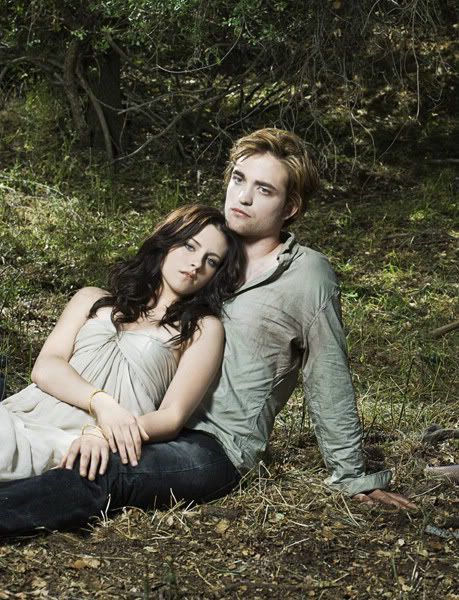Kristen/Bella BTS - DVD Extra Watch HERE and HERE
Interesting details from Trevor Hogg's interview with visual effects supervisors John Bruno, Phil Tippett, Edson Williams and Bruce Woloshyn about the making of The Twilight Saga: Breaking Dawn - Part 1...
“Bella [Kristen Stewart] gets married, has vampire sex, becomes pregnant, loses 30 pounds, gets sick, is close to dying, they forcibly get the baby out of her, she dies and comes back as a vampire in Part One; in Part Two, we get to experience everything that happens to her as a vampire. I thought, ‘Well, that’s different. I like this." recalls American Visual Effects Supervisor John Bruno.
Matters become worse for the pregnant lead character. “Bella is screaming because the baby is breaking her bones and she collapses to the floor; they throw her onto a gurney and take the baby out. It’s bloody,” recounts John Bruno. “The only thing we didn’t do in the book was to have blood spewing everywhere.”
“Renesmee was based on the performances of over 30 babies captured using the Lola projection rig,” remarks Edson Williams. “We ended up using small bits and pieces of about 5 of these babies to created the final look, like a patchwork quilt Franken Baby. The eyes were CG and based on the actual eyes of baby Kristen Stewart.”
Helping the visual effects supervisor was the courageous support of the lead actress. “Kristen was a great sport. What we’re saying to her is, ‘We’re going to make you look not good.’ As an actress her whole thing is about beauty and looking great; what we were going to do was beyond her control and she let us do it.”
“There’s a point where Edward thinks she dies; he takes out a big horse syringe full of vampire venom and stabs her in the heart. We did that as a medium-wide shot. When the film went out for ratings Bill called me and said, ‘We’ve got an R rating.’ I went, ‘Oh that means I’ve got to lose my favourite scene.’ The whole idea was that if you go through vampire lore you stab them through the heart to kill them but this was stabbing Bella through the heart to revive her. He said, ‘No, all the blood, and birth is fine. We have to cut back the sex scenes.’”
More on Kristen's (and Bella's) transformation under the CUT
Trevor Hogg /flickering myth.com Bill [Condon] told me they were going to break it up in two parts because the book was so large,” recalls American Visual Effects Supervisor John Bruno of his initial meeting with the Oscar-winning writer-director to discuss the cinematic adaptation of The Twilight Saga: Breaking Dawn. Bruno was intrigued by the concept. “Bella [Kristen Stewart] gets married, has vampire sex, becomes pregnant, loses 30 pounds, gets sick, is close to dying, they forcibly get the baby out of her, she dies and comes back as a vampire in Part One; in Part Two, we get to experience everything that happens to her as a vampire. I thought, ‘Well, that’s different. I like this.’” 1275 visual effects shots had to be completed within a schedule of three months. “It was broken down that the wolves would be [the responsibility of Phil] Tippett.” Beyond refining the signature shape-shifting creatures there were two more major issues. “The other things were the ‘Bella Effect’ and the Renesmee Baby, which in the next movie grows rapidly [into an adult].” Bill Condon needed to be guided through the unfamiliar world of visual effects. “Bill said, ‘I trust you know what you’re doing,’” recalls Bruno who had to address an overriding concern for the filmmaker; Condon did not want the performances of his actors to be replaced digitally. “The biggest thing in this whole approach was to never lose the expression and the emotion in the eyes of the characters.”
“In movie one, Bella was going to lose weight and look very bulimic,” states John Bruno who utilized a combination of practical and CGI effects to make the 200 ‘Bella Effect’ shots believable. Under the supervision of John Rosengrant, the creature effects company Legacy Effects made a series of appliances which were added to actress Kristen Stewart during a three hour makeup session; they were designed to sink in her eyes, and enhance her cheek bones, chin, and collarbones. Test footage was shot and sent to Lola VFX which was responsible for squeezing and thinning the image. “The main reason for using the prosthetics was the hope that many shots would be good enough in camera, and it would reduce the digital shot count,” explains Lola VFX Visual Effects Supervisor Edson Williams who had previously collaborated with Bruno on making Magneto (Ian McKellen) and Professor X (Patrick Stewart) look 25 years younger in X-Men: The Last Stand (2006). “It ended up creating more work for us because the appliances stuck out at the temples creating odd shadows that then had to be removed; in addition we had to deform the prosthetics down to where Kristen’s natural temple line existed.”
“Altering Kristen Stewart’s body was incredible challenging,” admits Edson Williams. “Fortunately, Legacy created an absolutely amazing life-size puppet of an emaciated Bella; we constantly referred back to it for the body deformations. Most of the shots had both facial and body deformations so we thinned up Kristen’s forearms and legs, and added bony ridges to her knuckles.” The original reference material had to be abandoned. “During our initial development phase of the ‘Bella Effect’ we viewed images of starving young women. The images were horrifying, and we immediately began to search for another source, something much softer. We ended referencing thin fashion and runway models with very defined jaws and cheekbones.” Adjustments had to be made. “John immediately noticed we were reducing the width of Kristen Stewart’s jawline; once we restored the original width, she immediately appeared more emaciated.” 3D head references were used for every shot. “Lola VFX developed a trick to shrink wrap a 2D image onto tracked 3D geometry. Essentially, we had two 3D heads of Kristen Stewart, one normal and one that has been emaciated in Z-brush. We projected the plate photography onto the normal 3D model; then based on surface normal transferred the colour to the emaciated 3D model. It worked because both models had the same number of vertices, and we were only deforming the orbital ridge and cheekbones.”
“Our biggest challenge was maintaining a consistent look across the shots,” reveals Edson Williams. “Changing the camera position and slight alterations in lighting created huge variations in Kristen’s face, so we would have to adjust the amount of deformations between each cut. Using a 3D tracked [PFtrack] emaciated Kristen Stewart, CyberScan was critical to this consistency and it allowed us to maintain exact placement of her orbital ridge and cheekbones. Eyes were always problematic because we had to sink them back into Kristen’s face without making her look ghoulish. Bill Condon was very particular with the look of Kristen’s eye region. We ended up reducing our initial work so the sunken eyes would not draw too much attention.” John Bruno was pleased with the final result. “Over the last 35 minutes of the movie, one of the characters says, ‘You look terrible.’ Kristen is a good 10 pounds thinner. You would have to A/B the [before and after] pictures to see that. Then there’s a scene where she stands up, lowers her rob and stares at herself in a mirror; her bones and ribs are showing. It gets a gasp from the audience.” Bruno observes, “It’s the big reveal in the movie and it pays off quite well.” Helping the visual effects supervisor was the courageous support of the lead actress. “Kristen was a great sport. What we’re saying to her is, ‘We’re going to make you look not good.’ As an actress her whole thing is about beauty and looking great; what we were going to do was beyond her control and she let us do it.”
Matters become worse for the pregnant lead character. “Bella is screaming because the baby is breaking her bones and she collapses to the floor; they throw her onto a gurney and take the baby out. It’s bloody,” recounts John Bruno. “The only thing we didn’t do in the book was to have blood spewing everywhere.” Kristen Stewart sat at a 30 degree angle in a chair situated underneath the examination table; left exposed was her torso, shoulders and arms while in front of her was placed the life-size puppet. The sequence is shot from the perspective of Bella. “Bill wanted the birthing event to be as visually realistic and emotionally riveting as possible for the audience. It was important for us to use Kristen Stewart as much as we could while shooting the scene. We wanted the audience to experience the birth with her which everybody says they did.” A Pulp Fiction (1994) moment occurs in the sequence. “There’s a point where Edward thinks she dies; he takes out a big horse syringe full of vampire venom and stabs her in the heart. We did that as a medium-wide shot. When the film went out for ratings Bill called me and said, ‘We’ve got an R rating.’ I went, ‘Oh that means I’ve got to lose my favourite scene.’ The whole idea was that if you go through vampire lore you stab them through the heart to kill them but this was stabbing Bella through the heart to revive her. He said, ‘No, all the blood, and birth is fine. We have to cut back the sex scenes.’”
Lola VFX also digitally manipulated the face of the newborn baby. “Renesmee was based on the performances of over 30 babies captured using the Lola projection rig,” remarks Edson Williams. “We ended up using small bits and pieces of about 5 of these babies to created the final look, like a patchwork quilt Franken Baby. The eyes were CG and based on the actual eyes of baby Kristen Stewart.” A CG baby was created for the scene at the fireplace when Jacob does his imprinting; he looks into the future and sees her age into a grown woman. The revelation sets up a key plot point for The Twilight Saga: Breaking Dawn – Part 2 (2012). “All the Renesmee shots are based on a 10-year-old actor named Mackenzie Foy, this proved challenging when we had to make this 10-year-old look 18,” states Williams. “To accomplish this task, we shot an 18-year-old model running though a park, and then captured Mackenzie’s performance in the Lola Projection Rig. Using Flame software, we modified Mackenzie’s facial featured to look much older, and then modified a CyberScan of Mackenzie to match the older proportions created in the Flame. The older looking Mackenzie image was projected onto the older looking Mackenzie 3D geometry, and then this combined data set was tracked onto the model running thru the park. To create an accurate representation of a future Mackenzie, we used the same techniques used to find missing children. It was fun trying to guess what a child would look like in 8 years, and these were the most enjoyable shots we worked on. In 8 years we get to find out how accurate our 18-year-old Mackenzie shot really is.
During the premiere of The Twilight Saga: Breaking Dawn – Part 1, the visual effects veteran witnessed for the first time in his 30 year career 7000 audience members screaming. Questioned about the final installment, John Bruno remarks, “Breaking Dawn – Part Two starts one minute after the last shot of this movie. We shot one and two at the same time in 31 days.” The sometimes the only difference onset would be a change in the furniture or the paintings on the wall would be switched. “The Wolf Clan joins the Cullen Clan to fight the Volturi Clan; it’s a giant battle in the end to kill the baby.” Phil Tippett remarks, “The shooting schedules on theses things are absolutely insane and we were shooting two movies, Breaking Dawn – Part 1 and Breaking Dawn – Part 2 back-to-back, which I do not recommend anybody doing because it’s hard enough to make one movie.” Tippett agrees with the studio decision to not follow a current technological trend sweeping Hollywood. “Summit knows their audience. The content doesn’t require 3D.” He adds, “Bill didn’t worry about technical things and was only concerned about the dramatic and story aspects of the show so all of the discussions were very creative.” Bruce Woloshyn believes, “The nice thing about Breaking Dawn is for all of the different vendors it ran the gamut of, ‘Wow, that’s a visual effect!’ to tons of stuff that’s invisible.”
Read in full

